Winter has come. After almost two years of waiting (and over 70 hours of screentime), “Game of Thrones” season 8 episode 3 has revealed itself on HBO.
Here at Super, we wish to share our excitement by re-watching the episode with you. But instead of a recap, we will detail all the Easter Eggs, little references and how all the little clues tie in to the great story that George R.R. Martin—and by extension, showrunners D.B. Weiss and David Benioff—are telling. We will tie in every little thing in these episodes with the events that have happened in the past.
Yes, we will turn everyone in Three-Eyed Ravens, able to see the events on Westeros from season 1 to season 8 all at once. We will share and savor the Maester-level intelligence. This is the best, and we believe, the only way to truly appreciate for what the most anticipated season of TV ever.
So massive, SUPER SPOILER warnings on a level never seen before.
The new opening credit sequence is almost exactly the same as the one from episode 2, save for how the ice-blue tiles are now all the way to Winterfell.
Location: Winterfell
As befitting an episode about the Battle of Winterfell, this entire episode is set in Winterfell, same as the second episode, making these the only two episodes in the entire series to be set in one place.
In a nice touch, when the credits descend into the crypts, the lit torches are snuffed out one by one, heralding the advance of the Night King (Vladimir Furdik).
The episode title, “The Long Night,” refers to the last time the Night Ling came around, with the winter that lasted a generation.
“GOT” changed the way medieval war was depicted on screen. At the beginning, the show skirted the open field, choosing to do the battle off screen (the Battle of the Whispering Wood in season 1) or to set it in a limited setting (the Battle of Blackwater in season 2). They had been showing an increasing ability to depict fighting onscreen that reached its first high point at the Battle of Hardhome in season five, where, in the broad daylight, humans were shown fighting the undead in very dynamic settings, on a big scale. Never again would GOT be afraid to stage battles large and small on the screen. This all culminated in the Battle of the Bastards in season 6. In that episode, director Miguel Sapochnik (also the director of the Hardhome episode) showed combat in the GOT setting that was actually as beautiful as it was meaningful.
Sapochnik returns to direct this episode, the first feature-length episode at 82 minutes in GOT history.
At the end of the second episode, all the forces that would fight together against the Army of the Dead were already gathered inside and right outside Winterfell: the Dothraki led by the Bloodrider Qhono (Staz Nair) and Ser Jorah Mormont (Iain Glen), the Knights of the Vale, the Starks and theit bannermen (notably the 62 fighters of House Mormont), the Wildings led by Tormund Giantsbane (Kristofer Hivju), the Ironborn led by Theon Greyjoy (Alfie Allen), the Unsullied led by Grey Worm (Jacob Anderson) and the Night’s Watch led by Dolorous Edd (Ben Crompton), plus the various individuals pledged to the fight such as Beric Dondarion (Richard Dormer), The Hound (Rory McCann), Ser Brienne of Tarth (Gwendoline Christie) and Jaime Lannister (Nikolaj Coster-Waldau). From last episode, we also know that any able-bodied man in Wintertown has been pressed into fighting to defend Winterfell.
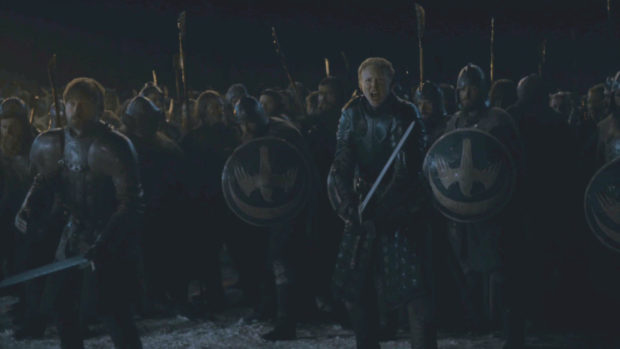
It is deep past midnight when the White Walkers approach Winterfell.
The chaotic first sequence is a brilliant one-shot relay where we see how different people are preparing for the imminent siege, notably a frightened Samwell Tarly (John Bradley), a grim Tyrion Lannister (Peter Dinklage) and an ever taciturn Bran Stark (Isaac Hempstead Wright).
It was shown last episode that the women, children, elderly or those who cannot fight would be in the crypts. Sam and Tyrion were told to be there. Sam insists he can fight and he is shown taking a Dragonglass weapon off the rack and heading to the front line. Tyrion takes a container of wine and heads to the crypts.
Before anything else, let us define the enemy.
The wights are zombies, and in every onscreen iterations, zombie have rules. In GOT, the rules are as follows:
Wights are animated corpses. One must be killed first as a mortal and then the Night King would have to resurrect them.
The wights, being corpses, start to decompose immediately, so those wights who had been reanimated for a long time are basically just skin and bones.
Wights can only be killed by three things: fire, Dragonglass and Valyrian steel.
Wights can be cut into pieces by conventional weapons, but they would continue moving unless the three aforementioned means are used.
Even if you are bitten by a wight, you cannot turn into a wight so long as you are alive.
Wights are fast, moving in herds and packs.
A White Walker is not a wight. It is alive, a magical creature who can also reanimate corpses on their own. White Walkers can only be killed by Dragonglass or Valyrian steel.
If you kill a White Walker (we’ve seen Sam do this), all the wights animated by that White Walker immediately falls.
There remained one last player on the field who had not yet shown up in the previous two episodes. She shows up here. Melisandre (Carice van Houten) appears on horseback right before the battle. The last time we saw her, she had been banished from the North for having sacrificed Shireen Baratheon to the Lord of Light. Jon Snow (Kit Harington) and Davos Seaworth (Liam Cunningham) both promised they would execute Melisandre if she ever came back, but here she is. She is of course following the predetermined path set for her. Melisandre assures Davos he won’t have to kil her; she won’t survive the dawn.
There are those Valyrian words again, this time from Melisandre to Grey Worm: “Valar morghulis, valar dohaeris” (all men must die, all men must serve) particularly apt this episode.
Melisandre uses her magic to set the Dothraki’s weapons on fire, something that sparks courage in the Dothraki. The shot of the weapons lighting up, from left to right, is quite something.

The Dothraki cavalry, led by Jorah and hello direwolf Ghost, charges at the army of the dead, which we cannot actually see.
So the effect of seeing tehe lights of the Dothraki go out one by one until they are all out is spectacularly frightening.
The waiting defenders see just a precious few, including one or two Bloodriders, Ghost and a bloodied Jorah, ride back.
So the Unsullied take on the wights, whom we see just a little before the darkness overtakes us.
Let’s talk about the battle plan. In the previous episode, “A Knight of the Seven Kingdoms,” it was spelled out: Use Bran as bait in the Godwood protected by the Ironborn to draw out the Night King while the rest of the forces buy time by fighting the wight army. The dragons Drogon and Rhaegal will wait until the Night King arrives to attack him.
As we pointed out last time, this plan is lunacy.
It is predicated on sacrificng fighting men until the big bad shows up. The actual staging of the battle makes even less sense, particularly the loss of the Dothraki. Ligjt cavalry is used to flank enemies, not lead the charge in a defensive battle. They would have been better used as fast attackers around the walls when the horde comes close.
The dragons were originally misused in Jon’s ridiculous plan, but once Daenerys Targaryen (Emilia Clarke) sees her Dothraki wiped out, she breaks from the plan and attacks the wights with the most powerful weapon they had, actually using the dragons correctly, especially when Jon joins here.
The Unsullied, notably doing what they should be doing, fall before the wights but the hold their ground.
The big plan falls apart again as the plan to light the trench fails as the dragonriders can’t see Davos’ signal, the burning arrows are snuffed out and the men sent to light the trench are attacked. It takes Melisandre in her second big display of magic to light the trench, buying them time.
In Westeros, magic is a finite substance, and this is the limit for Melisandre. She has no more magic up her sleeve—but still a trick or two.
Back to an update on the wights: When the wights reach the trench, the Night King simply makes them fall on the fire until there are enough bodies to make a kind of organic bridge, which the other wights use to swarm across. So much for the trench.
When the wights reach the walls, they use the bodies of their own to climb up, a movement truly reminiscent of the zombies in the excellent film “World War Z.”
The fortress falls under the assault.
Dolorous Edd dies saving Sam. Lyanna Mormont (Bella Ramsey) dies fighting a wight giant.
Meanwhile, dragons Drogon and Rhaegal fight zombie Viserion in the clouds. This is a spectacular sequence, among the best in the series. It is clear Sapochnik had taken inspiration from World War II dogfights just as George Lucas had done for the Death Star trench scene in 1977’s “Star Wars: Episode IV—A New Hope.”

When Jon tries to attack the Night King, the Night King resurrects the recent dead to get in his way.
The Night King can’t be killed by dragon fire (something Arya asked) because he was made by the Children of the Forest with dragonglass. Unlike the wights and the White Walkers, he can only be destroyed by Valyrian steel.
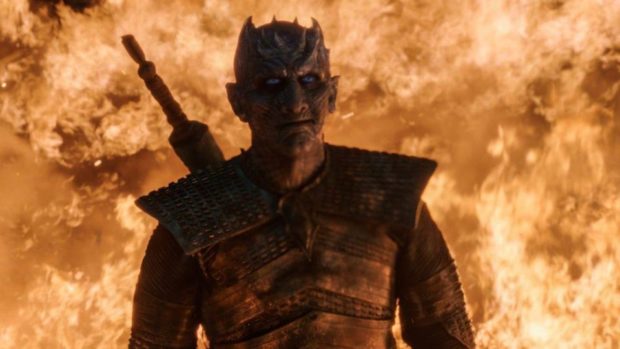
By the way, this is the Night King’s first and only appearance this season.
Another wight update: As shown in the Hardhome battle, the Night King’s resurrection magic works geographically, radiating around him in a concentric circle. So the bodies right around the Night King are the first to resurrect, the ones in the courtyard next and the ones in the crypts, underground and enclosed in stone, last.
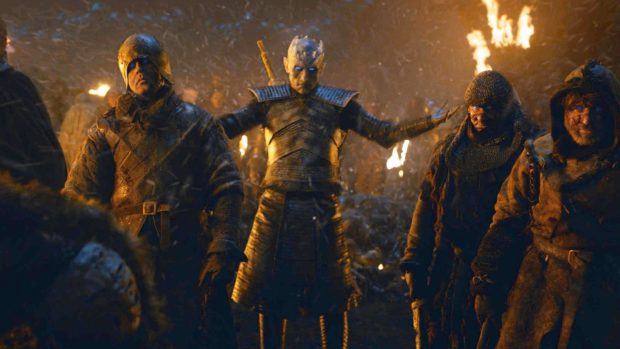
Take note that, by this time, the defenders had taken down a LOT of wights. Those wights, killed by the trio of fire, Dragonglass and Valyrian steel, stay dead. It’s the human defenders killed by the wights who come back as new wights. So while the number of new wights are still many, it’s nothing compared to the previous number of wights in the original army of the dead.
This is why it was possible to still fight them. It makes some sense that elite fighters such as Tormund, Brienne, Jaime and The Hound—trained to take down multiple attackers on their own—would survive such a siege. It makes less sense for civilians like Podrick (Daniel Portman) and Gendry (Joe Dempsie) to survive against such a threat. In fact, Sam only survives by pretending to be dead.
After all, two elite fighters, Jorah and Beric, do not survive their wounds.
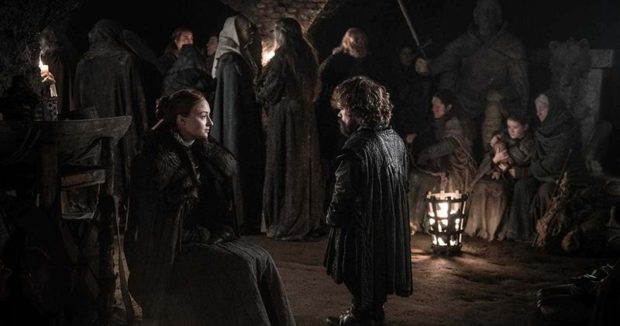
It makes even less sense for Sansa (Sophie Turner), Tyrion, Varys (Conleith Hill). Missandei (Nathalie Emmanuel) and Gilly (Hannah Murray) together with Little Sam and the girl with the burnt face to all survive.
To begin with, the plan to hide them in the crypt was dumb because they were literally surrounded by corpses ready to be reanimated by the Night King. But how is it possible for these precise characters to survive in an enclosed space full of attacking wights?
Another wight update: as shown by the library sequence, the wights don’t notice you by smell or sight. They notice you by sound.
All this is important because, in season 8, the showrunners are practicing Chekhov’s Steel Dagger, where any element introduced must figure in the resolution later.
Which brings us to Arya Stark (Maisie Williams). She is the greatest joy in this episode as she is one of five characters whose story arcs come to fruition this episode—but she is the only one to survive. She gets to use the exact fighting skills she learned in Braavos, using a weapon she designed and gets to use the ninja-level sulking around skills. The signs were clear that the showrunners fully intended to use Arya as the key all along, culiminating in the scene from last season when Bran handed the Valyrian Steel dagger to her.

She just needs pointing in the right direction, direction provided by Melisandre. She told Arya previously that she would be closing many eyes, “brown eyes, blue eyes, green eyes.” The blue eyes are the Night King’s. And the question, “What do we say to the god of death” was originally uttered by Arya’s “dance” teacher Syrio Forrel back in season 1. Arya has been saying “Not today” this entire time.
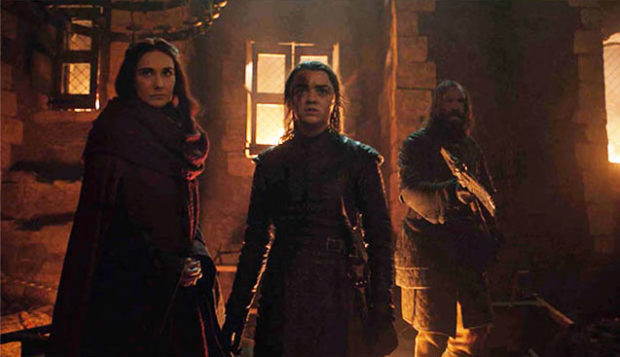
Jon is the big decoy in this episode and in this series, it turns out. The showrunners eshew any kind of azor ahai prophecy in their decision to use Arya as the killing blow.
In fact, Jon and Dany are not really important to the plot of this episode.
Beric dies as his arc is done, having been resurrected by Thoros of Myr precisely 19 times so he can give up his life to save Arya.

Jorah dies defending Dany to the very end. Wounded mortally, he does not go down until he is sure Dany is safe. He is the original Dany admirer, all the way back to the first episode of the series. Together with Lyanna, he exemplifies the Mormont words: “Here we stand.” And yes, with the cousins’ deaths, House Mormont is now extinct, along with House Umber.
Theon had the best redemption arc, partly because he had to redeem himself for so much. His role was to defend Bran long enough for Arya to get into place, for the Night King to be standing right there. He did just that.
The final character whose arc was complete was Melisandre. She had used up her magic and told Arya what she needed to do. The necklace she wore, originally full of fiery red stones, is down to one fading one, and once she took it off, she grew to her actual age immediately. She, too, did her part.
To be fair, Arya’s ability to provide the killing strike was much hinted at. Jon actually asked her, “How did you sneak upon me” in the Godswood, and we saw how Arya was so quiet she could sneak around the wights without being noticed. And the switching of hands was what she did while practicing with Briene back in season 6 episode 4, “The Spoils of War.”
All this was foreseen by Bran. What was he doing this whole time? Making sure everything happened how and when and where it was supposed to happen.

Long since divorced from the books, GOT the show suffered a bit from having to fit in all these happenings in six episodes. It got a bit heavy-handed from a writing standpoint.
But the direction was top notch. Whether you agree with the battle tactics or not, Sapochnik nails it.
Also awesome this episode, the series’ secret MVP, composed Ramin Djawadi. His previous high was “Light of the Seven” back in the “Winds of Winter” episode. His “The Night King” tops that, perfectly accompanying the last act of the episode.
In the process, they turned Arya Stark’s killing the Night King into one of the most compelling TV moments of all time.
This battle, though, might turn out to be as big a decoy as Jon Snow. The Great War is over, but the Last War remains to be won, in the words of Dany from the episode 4 trailer.
We also know Sapochnik is directing the feature-length episode 5, the Battle of King’s Landing. The showrunners had previously shot King’s Landing from a distance or from the air, using Dubrovnik in Croatia.
But we know a sprawling new King’s Landing set was built on the famously oversize “Titanic” soundstage (yes, that’s where they shot the James Cameron film), so a lot is going to happen in episode 5, presumably after the prerequisite episode 4 set-up.
So perhaps the Battle of Winterfell itself is just a decoy for a killer Battle of King’s Landing.
One can always hope.
Deaths: Dolorous Edd, Lyanna Mormont, Qhono, Beric Dondarrion, Jorah Mormont, Theon Greyjoy and a LOT of unnamed folks. And the Night King.
Best line: Arya Stark: “Not today.”
Game of Thrones” season 8 episode 4 airs on HBO on Monday at 9 a.m. with a primetime replay at 10 p.m.









































